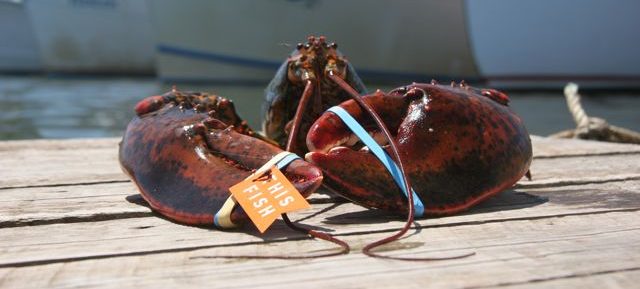How To Cook A Live Lobster

Perfectly cooked lobster is surely one of life simplest pleasures. Live Maine Lobsters are a snap to cook. Steaming and boiling are the two most common ways to cook lobsters. In the winter, lobsters have a harder shell and therefore require more time to cook. In the summer, the lobsters have a softer shell and require less time.
Did you know Cooper’s sells wholesale Lobster Tails all year round and offers Lobster Tails at our Holiday retail seafood market? Call us for Lobster prices now! 570-346-6883
Cooking Live Lobster at Home
Cooking lobster is an art, and if you do not get the timing just right, you might be in for a tough or chewy lobster. Never overcook your lobster. This makes the meat tough and stringy. You’ll find plenty of lobster cooking tips online, but we find most of the times are way too long.
What Size Lobster Pot?
Whether you steam or boil, pick a pot with lots of room. Do not crowd the lobsters in the pot as the heat will not circulate evenly around the lobsters. If you do not have a big pot, cook lobsters in batches, using a couple of pots. A 4-5 oz. soup pot will work well for a couple lobsters. A 19-quart pot will cook about 5-6 lobsters. The pot does not have to be heavy duty as water will actually boil faster in a lighter gauge metal pot.
If you have never handled live lobster before, keep the bands on! Carefully remove them before cooking. Some lobstermen insist on removing the claw bands before cooking. Rubber bands they say impart an off taste to the water.
How to Steam Lobsters
Steaming cooks whole lobsters more slowly than boiling, so it reduces the chance of overcooking. It also makes less of a mess! Why steam lobster?
- Yields a more tender lobster than boiling.
- Lobsters are less diluted with water.
- Makes less of a mess.
- Timing is more accurate since the water returns to a boil faster
- Preserves the ocean fresh taste of lobster.
- Cooks lobster a little slower with less chance of overcooking.
Keep the lid on tight to keep in the steam. A steamer rack is not a necessity; it just keeps the lobsters from getting charred on the bottom of the pot. You can also use a vegetable steamer rack or an upside colander inside the pot.
Steaming Instructions:
- Use a pot large enough to comfortably hold the lobsters and fill water so it comes up sides about two inches. ( Feel free to use a steaming rack to place the lobsters on or just add directly to the pot.)
- Add 2 tablespoons of salt for each quart of water. If you have sea salt—even better.
- Bring the water to a rolling boil, and put in lobsters, one at a time. Bring water to a rolling boil over high heat. Place lobsters in the pot (head first), cover tightly, return to a boil as quickly as possible and start counting the time.
- Steam a lobster for 7 minutes per pound, for the first pound. Add 3 minutes per pound for each additional pound thereafter. See chart below for approximate cooking times. Regulate the heat if the froth starts to bubble over.
- Carefully remove lobsters from the pot with tongs. Be careful, they are very hot. Set in a large bowl for five minutes to cool before cracking.
If the roe inside a female body is blackish instead of the customary red, it is under cooked. Put the lobster back into the pot until the roe is red.
Steaming Lobster Times
Lobster Size: Cooking Times
1 lb.-1-1/4 lbs. — 7-9 minutes
1-1/2 lb. — 9-11 minutes
2 lbs.— 11-12 minutes
2-1/2-3 lb. — 12-14 minutes
5 lb. — 22-24 minutes
How to Boil Lobster
For cooking a bunch of lobsters, boiling gives you even fast cooking. However, boiling lobster tends to water-log them.Why boil lobsters?
- Best for cooking 4 or more lobsters at a time.
- Cooks lobsters more evenly than steaming.
- High, intense heat cooks the meat quickly, making it to easier to remove from the shell.
Boiling Instructions:
- Fill a pot (large enough to hold the lobsters) anywhere from one-half to two-thirds full with water. Deep enough to submerge the lobster by about 3 inches.
- Add 2 tablespoons of salt for each quart of water. (If sea water is available, even better. Skip the salt.) Bring the water to a strong boil over high heat.
- Place the live lobsters in one at a time, headfirst, completely submerging them. Pick up the lobster by holding the upper side of the thorax between your thumb and middle finger.
- Cover the pot tightly and return to a boil as quickly as possible. AFTER the water boils start timing, and regulate the heat to prevent water from boiling over, but be sure to keep the water boiling throughout the cooking time. Melt some butter while you wait.
- Carefully remove lobsters from the pot with tongs. Be careful, they are very hot. Set in a large bowl for five minutes to cool before cracking.
When a lobster boils it retains a lot of water. Pierce the body and tail with a knife to help drain the water.
Hold the underside of the body away from you, because the lobster have a tendency to flip the jointed tail, splattering water. You can cook more than one lobster in a pot as long as there is enough room and water to cover the lobsters. (If you do not have a big enough pot use two smaller pots or cook your lobsters in batches.)
Boiling Times for Lobsters
Lobster Size: Cooking Times
1 lb. Lobster… 5-7 minutes
1 1/4 lb. lobster… 7-8 minutes
1 1/2 lb. lobster… 8-10 minutes
2 lb. lobster… 10-12 minutes
3 lb. lobster… 12-14 minutes
5-6 lb. lobster… 18-20 minutes
How to Tell if My Lobsters are Cooked?
Another common mistake is adding to the cooking time just because you are cooking more than 1-2 lobsters in the pot.
Many people will mistakenly boil a two and half pound lobster twice as long as a quarter pound lobster.
Lobster is cooked when the shell is entirely red. When properly cooking lobster, the meat becomes a creamy white color all the way through–no translucent areas. Some chefs say when the antennae pull out easily, lobsters are done, but this is not always the case. Insert an instant read thermometer in the underside of the tail closest to the body. The internal temperature should read about 135-140 degrees F. It is important to note when you take your lobsters out of the pot they will continue to cook. To stop the cooking process, put your lobsters in a big bowl of ice.
If you overcook them, your going to be eating tough lobster. If you under-cook your lobster you can always heat them up. The reason many people believe larger lobsters are tough is simply because they overcook them.
Just remember to bring your pot back to a rolling boil and regulate the heat. The tail is a good indicator of freshness. It will contract and curl when cooked; and the tail meat will be somewhat firm, not mushy. Happy cracking!
